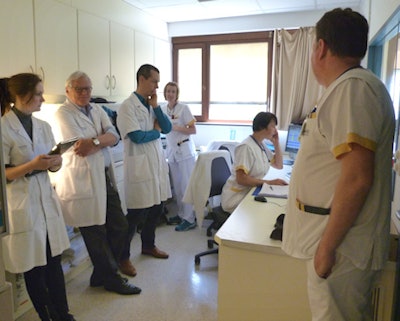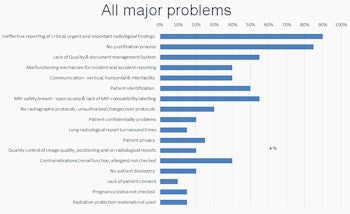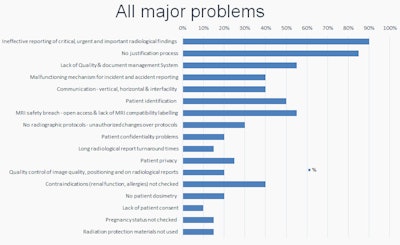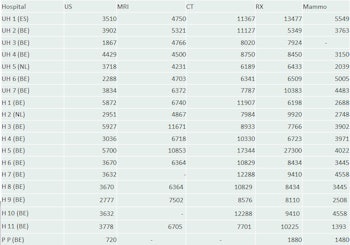
Compulsory clinical audits are on the horizon. Skeptics fear they are time-consuming and costly, interrupting daily practice and resulting in stressful and hurried activity followed by a gradual slackening in standards once the audit is over. But an emerging Belgian company is convinced audits can bring real benefits, and is claiming some notable successes.
Dr. Jan Schillebeeckx, chief medical officer of Qaelum, the patient safety and quality solutions firm that was previously affiliated with the University of Leuven but now is independent, said its vendor-neutral medical software solution for dose registration and management can provide total quality management for radiology departments. This online tool allows radiologists to remain constantly audit-ready, and reduces time spent by staff on preparation and the number of full-time equivalents (FTEs) involved in preparing for audits, he said.
 As of 6 February 2018, all radiology departments must undergo clinical audits. In this CT room, radiographers, nurses, and technicians undergo audit training in Belgium. Shown on the left are Evguenia Boldyreva, radiology technologist and head of training at Qaelum, Dr. Jan Schillebeeckx, and Tom Vanherpe, PhD, a researcher atQaelum. All images courtesy of Dr. Jan Schillebeeckx.
As of 6 February 2018, all radiology departments must undergo clinical audits. In this CT room, radiographers, nurses, and technicians undergo audit training in Belgium. Shown on the left are Evguenia Boldyreva, radiology technologist and head of training at Qaelum, Dr. Jan Schillebeeckx, and Tom Vanherpe, PhD, a researcher atQaelum. All images courtesy of Dr. Jan Schillebeeckx."Not all countries realize that the obligation to conduct clinical audits is just around the corner. However, Spain and Belgium understand that such a scheme must be put into place," he said.
Preparing for an audit typically involves three to 10 FTEs. Furthermore, information about how to comply clinically with audit requirements is dispersed throughout the department, and this scattering of data also hampers the process.
On the flipside, Schillebeeckx points out that the benefits of clinical audits are clear: Aimed at improving patient safety and care, they promote an efficient use of resources, enhance the provision and organization of clinical services, and support professional education and training, he explained. The need for automation in the audit process and a reduction in manpower required seem crucial, given the number of hours to date spent on their preparation and implementation.
Challenging requirements
In line with Council Directive 2013/59/EURATOM, every radiology department will need to undergo a clinical audit as of 6 February 2018. The manner in which they are implemented, and the remit of the audit, will be decided on by each member state.
To date, clinical audits have been carried out manually using the International Atomic Energy Agency's (IAEA) Quality Assurance Audit for Diagnostic Radiology Improvement and Learning (Quaadril), a methodology that involves auditing around 1,000 items, usually requiring the presence of an onsite audit team for at least four days.
Seeking to develop a solution to facilitate compliance with the regulations, Schillebeeckx, who also represents the European Society of Radiology (ESR) at the European Commission's eHealthStakeholder's Group, and Qaelum's co-founder and CEO Jürgen Jacobs realized that the firm's dose management software could be configured to allow radiology departments to conduct and organize clinical audits. The next step involved mapping the thousands of parameters contained in Quaadril to the company's tool.


Example of major problems discovered in audits, listed in order of occurrence. For each problem, the figure indicates the percentage the problem occurs in the 26 audited radiology departments.
Hospital departments also follow accreditation systems that involve further auditing, often with a huge overlap in the items checked for clinical audits. To obviate this duplication and save clinical work hours, Qaelum's team also mapped the full Quaadril standard against all the main accreditation systems across Europe and Russia. The Flemish government provided a grant of 2 million euros for the project.
Member states decide
European Union (EU) member states are not obliged to follow the full Quaadril template for radiology departments. The ESR proposes audits begin with a basic list of items to ensure patient safety. Once this program is established, departments can move to second-level audits that extend the items assessed, while level three is a focused audit for true excellence in service provision, the equivalent of a full Quaadril audit, according to Schillebeeckx.
Compatible with any of these levels, Qaelum launched its Coach product a year ago. So far, the Coach team has undertaken around 26 full clinical audits in a range of countries, straddling Spain, the Netherlands, Belgium, Germany, and the Middle East.
"Using Coach, a full clinical radiology audit and report can take less than two days, rather than a week. A key goal is for radiology personnel from any department to implement it without external auditors needing to be present," he commented.


This benchmarking table shows the number of exams performed per year on one machine so that departments can compare themselves with each other. UH = university hospital, H = general hospital, and PP = private practice. These examples were taken from mid-2016 using Coach.
Schillebeeckx, who is an editorial advisory board member of AuntMinnieEurope.com, outlined how the system makes all documents, standing orders, and instructions available to the right people at the right time. Clients also receive a report that reveals where they are compliant, where there are minor issues that could be improved over time, and where there are major issues that need to be addressed directly. Anonymized audits can also be made available for benchmarking purposes.
To make a case for its new tool, Qaelum needs to demonstrate that its software significantly reduces time and costs of clinical audits.
"So far the results are promising. The software certainly reduces the manpower needed. If we can prove that it saves just one FTE, it will pay off the cost of the annual rate for the system's maintenance," he said.



















